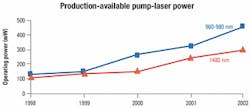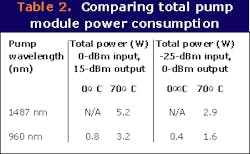Pump lasers at 960 nm for the L-band
When compared to 980- and 1480-nm pumps, 960-nm pump-laser modules provide several benefits.
KEN WANG, TOBY STRITE, and BERNARD FIDRIC, JDS Uniphase
Engineers face stiff challenges when designing L-band erbium-doped fiber amplifiers (EDFAs). To compensate for a reduced erbium ion emission cross section, more pump power and longer erbium-doped fiber (EDF) lengths that incorporate higher erbium ion concentrations are required, thus adding to EDFA cost, complexity, and power consumption. Achieving high gain at a low noise figure is a more difficult proposition than in the C-band. Pumps that operate at 960-nm wavelength, however, greatly ease the challenge of designing to difficult L-band specifications.
High-power 960-nm pump-laser modules are optimized specifically for L-band applications. The shorter pump wavelength improves EDFA efficiency by as much as 2.5 dB compared to conventional 980-nm pumps. High-power 960-nm pump lasers are also attractive replacements for one or more power-hungry 1480-nm pumps in the L-band. Although priced comparably, the 960-nm pump modules offer EDFAs better photon pumping efficiency, a lower noise figure, and greatly reduced power consumption and heat dissipation.
Pumps at 960 nm are suitable for both wideband DWDM EDFAs and narrowband amplet applications in the L-band. The options for 960-nm pumping will soon be extended to 500-mW power and >200-mW uncooled offerings that will create further opportunities to differentiate and optimize L-band amplifiers.
Pump-laser technologyFigure 2. This Raman design uses a single pump and depolarizer at higher wavelengths.Pump lasers operating at 980 and 1480 nm are commonly deployed in L-band EDFAs. The 960-nm pump wavelength provides higher power and greater efficiency, partly due to the superior properties of the aluminum gallium indium arsenide (AlGaInAs) material system when compared to indium gallium arsenide phosphide (InGaAsP)-based 1480-nm technology and partly because of the physics of pumping EDF.AlGaInAs devices have superior wall-plug efficiency due to less non-radiative recombination and material absorption compared to InGaAsP devices-when operated at the same optical output power. So AlGaInAs pump lasers require lower drive current and produce less heat. That is a significant advantage, since supplying the electrical power and dissipating excess heat are not only design challenges but add cost and increase the size of EDFAs. The thermal challenges of InGaAsP devices have limited the advancement of butterfly-packaged 1480-nm pump-laser power, whereas 960- to 980-nm AlGaInAs pump operating power is progressing more rapidly (see Figure 1).
L-band EDF typically incorporates a higher density of erbium (Er) ions to offset the reduced erbium emission cross section at the longer signal wavelength. However, the absorption cross section of erbium ions in silica peaks near 980 nm. As a result, 980-nm pump light is unable to penetrate deeply into L-band EDF. The resulting high population inversion near the pump-laser insertion point creates large amounts of undesirable amplified spontaneous emission (ASE), which erodes the efficiency of 980-nm pumping, among other undesirable effects. Nevertheless, the 980-nm pumping option still offers better noise figure performance than 1480 nm in L-band EDFAs.
Pumping at 960 nm, in which the pump light is less strongly absorbed, circumvents the ASE penalty. The shorter wavelength penetrates deeper into the EDF, producing more uniform inversion, so less pump power is dumped unproductively into ASE. Compared to 980 nm, a comparable 960-nm pump can produce 2.5 dB more of amplified signal power at the EDFA output. The higher pumping efficiency compared to 980 nm translates into lower pump-laser cost, fewer parts, lower power consumption, and reduced need for heat dissipation.Figure 2 shows simulation results and thus the principal advantage of 960-nm L-band pumping. The results were obtained using off-the-shelf Oasix software to model a single-stage, single-channel amplifier with a single-channel, 0-dBm, 1607-nm input signal over varying EDF lengths. The model considers five pump wavelengths (960, 965, 970, 980, and 1480 nm), with each pump power scaled to the same number of photons as 300 mW at 980 nm. The simulation reveals that 960-nm pumping generates 2 dB more gain when compared to the 980-nm pumping and similar output power when compared to the 1480-nm pump at optimum EDF length.
L-band EDFA resultsDesigning L-band EDFAs requires considerable optimization, depending on the specified number of wavelengths, gain flatness, noise figure, bandwidth, channel data rate, total power consumption, heat dissipation, and required mid-stage features (e.g., add/drop, dispersion compensation, and gain-flattening filters). To meet these requirements, designers choose from among many available L-band EDFs, vary the length of the EDF, optimize pump configurations and wavelengths, and apply various filter technologies. Studies have shown the advantages of 960-970-nm pumping to apply broadly to the L-band, from broadband high-power DWDM EDFAs to cost-optimized single-channel amplifiers, independent of the particular design details.Table 1 shows one experimental comparison of the gain and noise figure obtained using separately optimized 960- and 1480-nm pumping schemes and commercially available 1480-nm L-band EDF. For a direct comparison, the pump-laser powers are scaled to the same number of photons. The results show improved EDFA performance under 960-nm pumping for all key parameters across a broad range of operating conditions.
A dramatic advantage of 960-nm pumping is the reduced power consumption and heat dissipation (see Table 2) when compared to 1480 nm. The 230-mW 960-nm pump provides higher dBm output, yet still requires about 40% less electrical power than does the 150-mW 1487-nm laser.As system bandwidth and functionality increase and especially as fiber-optic systems move into the metro market, total EDFA power consumption and heat dissipation are becoming increasingly vital product differentiators. Higher efficiency reduces the need for heat-sinks and active cooling, which are bulky and costly. Part count is reduced and system reliability is improved. As a result, 960-nm-based designs are smaller and can offer increased functionality. Finally, as 960-nm technology becomes uncooled, system management and control software become substantially simpler.
Current 960-nm pump-laser modules are cost-competitive with high-end 1480-nm pumps. Their 300-mW power output enables a single 960-nm laser to replace two 1480-nm pumps in many designs, reducing component count and EDFA size. Deploying 960-nm pumps in place of 980-nm devices increases L-band EDFA efficiency while preserving the noise figure available with short-wavelength pumping.
Importantly, the design and manufacture of 960-nm chips and pump modules requires only minor modifications to existing 980-nm technology. As a result, product developments recently introduced in 980-nm pump modules can be rapidly incorporated into the 960-nm variant.
In the near future, 960-nm pumps will be extended to 500-mW fiber-coupled power, further tilting the economics of booster-stage pumping toward AlGaInAs devices. Uncooled 960-nm pumps providing up to 220 mW of power while dissipating <1 W will be introduced for input-stage and narrowband L-band EDFA applications. Eliminating the bulky thermo-electric cooler will allow the introduction of uncooled 960-nm pumps in ultra-low-cost, smaller packages selling at a fraction of the price of a comparable cooled pump module.
The advent of high-power 960-nm pump modules has presented designers of L-band EDFAs with a powerful new tool to streamline designs for reduced cost, complexity, and power consumption. The technical advantages of 960-nm pump lasers and the innovations in the pipeline portend rapid advances in L-band EDFA performance in the coming years.
Qing "Ken" Wang is marketing manager for pump modules at JDS Uniphase (San Jose, CA). He can be reached at [email protected] uniphase.com. Toby Strite is regional marketing director for pump modules at JDSU in Hagendorn, Switzerland, and Bernard Fidric is the program manager for L-band amplifiers at JDSU in San Jose. The authors wish to thank colleagues Clem Burton, Julia Piehler, David Mehuys, Alexander Schoenfelder, and Jo Major for their contributions to this article.




